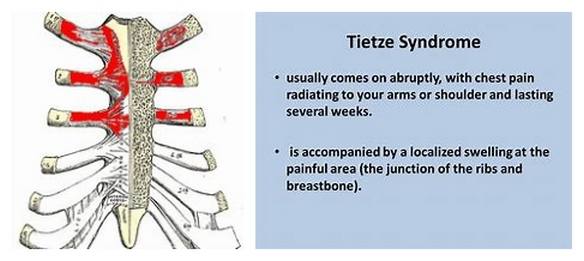Tietze syndrome is the inflammation of one or more coastal cartilages that joins your ribs to your breastbone (sternum). The first noted instance of this syndrome goes back to 1921, discovered by German surgeon Alexander Tietze. The area where ribs are joined to the breastbone by the cartilage is known as the costochondral joint. The costochondral joint becomes inflamed resulting in pain, tenderness and swelling of the joint which may cause temporary impairment. Tietze syndrome is very easily mistaken for a heart attack or chest wall pain. It is considered to be a benign syndrome which often resolves on its own.
Symptoms of Tietze syndrome
Tietze’s Syndrome is often misdiagnosed as myocardial infarction (heart attack) or costochondritis (chest wall pain) because of the similar symptoms displayed by these diseases.
- The most prominent symptoms of this syndrome include localized acute pain in the upper four ribs, second and third being the most affected.
- A firm, spindle- shaped swelling occurs in the cartilages resulting in tenderness and acute, neuralgic pain in the costochondral junction, or the joints between the ribs and coastal cartilage in the front of the rib cage.
- Rhythmic pain occurs during breathing and, in some cases, the pain might spread to the neck, shoulders and arms.
- The symptoms of costochondritis are also similar, the only difference being the swelling of the coastal cartilages which is not observed in costochondritis. The pain caused by this syndrome is often identical to that of a heart attack resulting in anxiety attacks, passing out, temporary paralysis, etc.
- In women, Tietze syndrome is often misdiagnosed as mastalgia due to the identical nature of their symptoms.
- Costosternal Chondrodynia is a rare variant of the syndrome which is characterized by severe breast pain in individuals who have had reconstructive breast surgery.
Causes
Tietze Syndrome is an idiopathic disease which means though the disease has been known for a long time, there is no specific cause established. However, the medical fraternity has widely accepted the following as the causes of this syndrome.
- Inflammation of any body part is generally caused due to an infection or virus. Upper respiratory tract infections like sinusitis and laryngitis are said to be a contributing factor in the inflammation.
- Strain on the chest by activities like heavy exercising, extreme laughter, severe coughing which impacts the chest, vomiting, sneezing etc. are responsible for Tietze’s Syndrome.
- Injury to the chest is another factor held responsible for the syndrome. Minor injury to the chest might be a cause of the syndrome resulting in severe pain in the chest area even with slightest movements.
- Those who have been treated with radiation therapy are more vulnerable to Tietze Syndrome immediately after the therapy or also years later.
- In some cases, Tietze Syndrome may follow other disorders such as psoriatic arthritis.

Diagnosis
- The diagnosis of Tietze Syndrome consists of a thorough physical exam, recent medical history evaluation and a couple of medical tests. Since the symptoms are very similar to a fatal disease like myocardial infarction, physicians recommend the following tests to rule out its possibility.
- A chest X-ray might be recommended to get a closer look at your ribcage bone structure to confirm results of the physical exam.
- An Electrocardiogram (ECG) report to document the statistics of your heart.
- Other tests used to image the insides of your body are ultrasound scan and magnetic resonance imaging (MRI).
- Blood tests like the sedimentation rate test or C-reactive protein test might be recommended for signs of inflammation.
Diagnosis of Tietze syndrome might be of big relief to those who think the symptoms had been caused by a heart attack.
Living with the disease
![]()
Tietze syndrome Women
Since Tietze Syndrome is an idiopathic disease, most of your treatment procedures are concentrated on easing your pain while the disease resolves on its own. A support group on The Experience Project has documented many stories of Tietze Syndrome survivors. “I’m 25 years old and I’ve been suffering from Tietze for the past 10 years” said a survivor in a post encouraging will power as a tool to fight the disease. She further adds, “I continue to fight the good fight, and am fortunate to have family and friends that believe (in) me”, stressing the need to stay positive throughout the entire course of treatment.
Treatment
The treatment of Tietze Syndrome is required in cases with extremely acute pain. Otherwise, it tends to improve on its own within a few weeks. Treatment options usually offered are:
The most advised treatment option for the syndrome is to take rest. Avoid any kind of physical activity which strains your chest or ribcage area aggravating the situation. Since a good amount of Tietze Syndrome cases tend to improve naturally, rest is important for the healing process. Avoid all kinds of sports or outdoor activities until the inflammation in your rib cartilage goes down.
Non-steroidal anti-inflammatory drugs (NSAID) are commonly used to treat Tietze Syndrome and help relieve or control the inflammation and pain. Ibuprofen and aspirin are some of the most widely used NSAID drugs used in the treatment process.
Corticosteroids injections might be used in extreme cases of Tietze Syndrome which are injected in and around the costochondral joint, relieving pain and swelling. Over usage of corticosteroid injections might result in damage of your costochondral joint.
A study published by Eefje Gijsbers and Simon F. C. Knaap has claimed chiropractic management as a possible treatment option.

